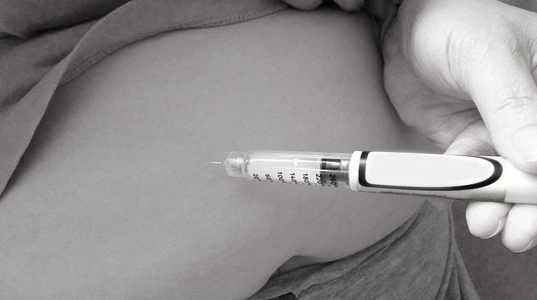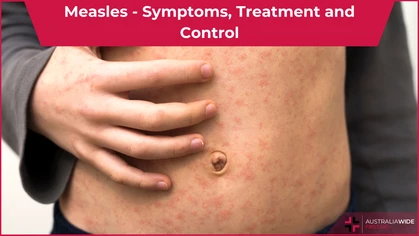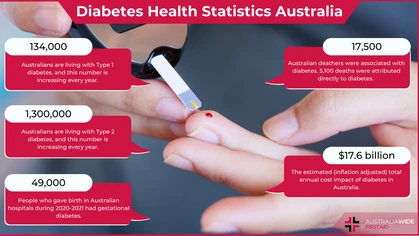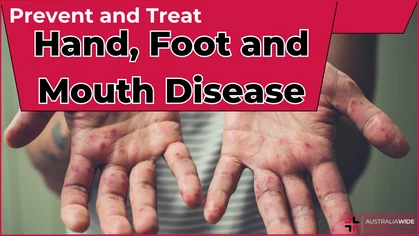Type 1 Diabetes, Type 2 Diabetes – Know the Difference

Disease

Type 1 Diabetes and Type 2 Diabetes
In Australia, people are diagnosed with Diabetes at a rate of one every 5 minutes.- Type 1 accounts for 10% of Diabetes in Australia and is increasing
- Type 2 accounts for 85% of Diabetes in Australia and is increasing
What's the Difference between Type 1 Diabetes and Type 2 Diabetes?
- Type 1 Diabetes is a chronic condition in which blood sugar (glucose) levels become too high due to the pancreas not producing enough of the hormone insulin.
- Type 2 Diabetes is a chronic condition in which blood sugar levels become too high due to the body developing resistance to insulin.
Type 1 Diabetes
Type 1 Diabetes is an autoimmune disease. What causes it is not yet known. What we do know is that the immune system destroys cells in the pancreas that produce insulin. It’s not linked to modifiable lifestyle factors and it cannot be prevented. Australia has one of the highest rates of Type 1 Diabetes in the world. It can occur at any age, with most cases developing in children, teenagers and young adults. Its onset is usually abrupt and its symptoms are obvious — excessive thirst and urination, weight loss, weakness, fatigue, and blurred vision. It is managed with insulin injections several times a day or the use of an insulin pump.Type 2 Diabetes
Type 2 Diabetes is a chronic condition in which sufferers become less responsive to the effects of insulin and/or their pancreas loses the ability to produce enough insulin. It is genetic, and can be passed down through family members. Traditionally developing mostly in adults over the age of 45, it is occurring more frequently nowadays in children, teenagers and young adults. Type 2 Diabetes is preventable and can be delayed in 58% of all cases. While we don’t know its cause, sufferers who modify lifestyle risk factors will successfully mitigate the impact of the disease. Early signs of Type 2 Diabetes can include heart attack, vision problems, or foot ulcers. Type 2 Diabetes is progressive and is managed with regular exercise, healthy diet, and weight reduction. In addition to lifestyle changes, most Type 2 sufferers will need oral medication and / or insulin injections. Maintaining a healthy weight is a must for people with Type 2 Diabetes. A protein rich diet, low in saturated fats and high in fibre is recommended, along with 30 minutes of exercise, 4 times a week. Prescribed medications need to be taken as scheduled. And monitoring of blood sugars and cholesterol levels should be done according to healthcare provider recommendations.Gestational Diabetes
Gestational Diabetes can occur during pregnancy, causing blood sugar levels to rise during this time. Gestational Diabetes in Australia — like Types 1 and 2 — is also increasing. Gestational Diabetes is not Type 3 Diabetes, however.Type 3 Diabetes
Type 3 Diabetes is being proposed by researchers to describe their theory that insulin abnormalities in the brain are responsible for Alzheimer’s disease. Proposed but as yet, not widely accepted, this Type 3 Diabetes is also not to be confused with Type 3c Diabetes Mellitus, also known as T3cDM, pancreatogenic diabetes, and type 3c diabetes. According to a study in 2016, people with Type 2 Diabetes are up to 60% more likely to develop Alzheimer’s disease or another type of dementia, such as vascular dementia. Another study of more than 100,000 people living with dementia, indicates that women with Type 2 Diabetes are more likely than men to develop vascular dementia. The researchers promoting the Type 3 Diabetes diagnosis, suggest that slowing the progression of Alzheimer’s or vascular dementia is possible through diet, exercise, and medication.COVID-19 and Diabetes
Compared to people hospitalised with coronavirus who do not have Diabetes, Type 1 Diabetes sufferers have been found to be 3.5 times more likely to die in hospital, and people with Type 2 diabetes, twice as likely to die. Studies show that Diabetes sufferers are more likely to be admitted to intensive care units. They are prone to disease “severity”, as well as more likely to experience worse outcomes from infections, including COVID-19.Why is Type 1 Worse than Type 2 in COVID-19 Cases?
Generally a Type 1 sufferer is likely to have had Diabetes for much longer than a person with Type 2. The longer you’ve had Diabetes, the more likely you would be prone to complications, including damage to the heart and kidneys. With Type 1, the cells that make insulin are being destroyed by the immune system. This is different from Type 2, which is not a disease of the immune system. And compromised immune systems are already known to be at great risk from Covid-19. Blood sugar levels are, on average, higher in people with Type 1 than with Type 2 Diabetes. People with Diabetes who contract COVID-19 are clearly at a greater risk of worse outcomes, including death. In light of the vast numbers of Diabetes sufferers worldwide, they represent a worryingly large and vulnerable proportion of the COVID-19 population. For people with Diabetes, poorer prognosis is the consequence of hyperglycaemia and comorbidities — in particular, hypertension, obesity, and cardiovascular disease.Diabetics during lockdown
During a lockdown, it's reasonable to assume that not everyone is getting their exercise or maintaining healthy diets. It's equally reasonable to suspect that while efforts are being made to reign in COVID numbers, Diabetes numbers are quietly escalating.
Originally published at
https://www.australiawidefirstaid.com.au/resources/difference-between-type-1-diabetes-and-type-2-diabetes
as part of the Australia Wide First Aid Articles Library









